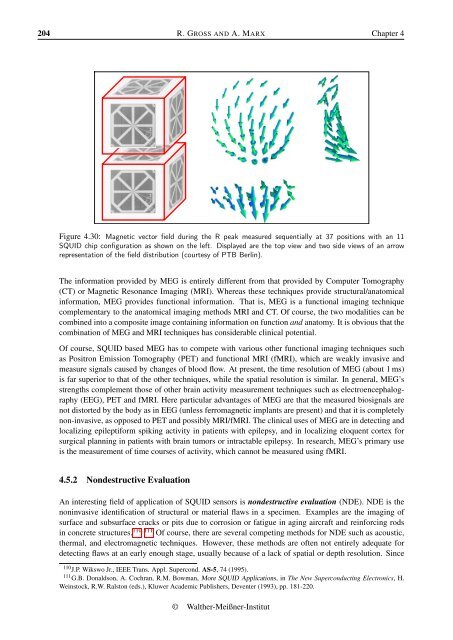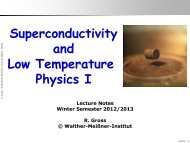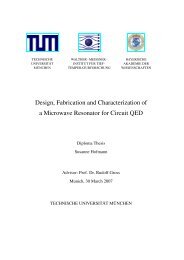Applied Superconductivity - Walther Meißner Institut - Bayerische ...
Applied Superconductivity - Walther Meißner Institut - Bayerische ...
Applied Superconductivity - Walther Meißner Institut - Bayerische ...
- No tags were found...
Create successful ePaper yourself
Turn your PDF publications into a flip-book with our unique Google optimized e-Paper software.
204 R. GROSS AND A. MARX Chapter 4Figure 4.30: Magnetic vector field during the R peak measured sequentially at 37 positions with an 11SQUID chip configuration as shown on the left. Displayed are the top view and two side views of an arrowrepresentation of the field distribution (courtesy of PTB Berlin).The information provided by MEG is entirely different from that provided by Computer Tomography(CT) or Magnetic Resonance Imaging (MRI). Whereas these techniques provide structural/anatomicalinformation, MEG provides functional information. That is, MEG is a functional imaging techniquecomplementary to the anatomical imaging methods MRI and CT. Of course, the two modalities can becombined into a composite image containing information on function and anatomy. It is obvious that thecombination of MEG and MRI techniques has considerable clinical potential.Of course, SQUID based MEG has to compete with various other functional imaging techniques suchas Positron Emission Tomography (PET) and functional MRI (fMRI), which are weakly invasive andmeasure signals caused by changes of blood flow. At present, the time resolution of MEG (about 1 ms)is far superior to that of the other techniques, while the spatial resolution is similar. In general, MEG’sstrengths complement those of other brain activity measurement techniques such as electroencephalography(EEG), PET and fMRI. Here particular advantages of MEG are that the measured biosignals arenot distorted by the body as in EEG (unless ferromagnetic implants are present) and that it is completelynon-invasive, as opposed to PET and possibly MRI/fMRI. The clinical uses of MEG are in detecting andlocalizing epileptiform spiking activity in patients with epilepsy, and in localizing eloquent cortex forsurgical planning in patients with brain tumors or intractable epilepsy. In research, MEG’s primary useis the measurement of time courses of activity, which cannot be measured using fMRI.4.5.2 Nondestructive EvaluationAn interesting field of application of SQUID sensors is nondestructive evaluation (NDE). NDE is thenoninvasive identification of structural or material flaws in a specimen. Examples are the imaging ofsurface and subsurface cracks or pits due to corrosion or fatigue in aging aircraft and reinforcing rodsin concrete structures. 110,111 Of course, there are several competing methods for NDE such as acoustic,thermal, and electromagnetic techniques. However, these methods are often not entirely adequate fordetecting flaws at an early enough stage, usually because of a lack of spatial or depth resolution. Since110 J.P. Wikswo Jr., IEEE Trans. Appl. Supercond. AS-5, 74 (1995).111 G.B. Donaldson, A. Cochran, R.M. Bowman, More SQUID Applications, in The New Superconducting Electronics, H.Weinstock, R.W. Ralston (eds.), Kluwer Academic Publishers, Deventer (1993), pp. 181-220.© <strong>Walther</strong>-Meißner-<strong>Institut</strong>
















